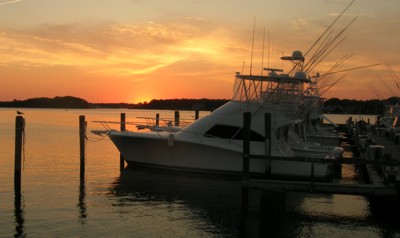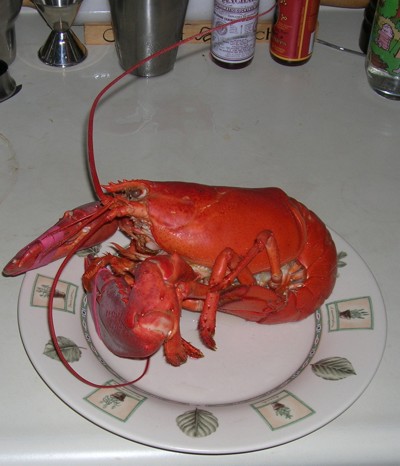After a long summer of diving, Captain Dan offered a mid-week crew trip. He assembled the usual suspects and made plans for an offshore trip. Mother nature had other ideas, so we diverted to an inshore trip to the U.S.S. San Diego which lies a few miles off of Fire Island. With a diverse collection of rebreathers loaded aboard, we headed off.
 The USS San Diego was a WW I cruiser believed to have struck a mine back in 1918. The wreck now lies upside down in 110 ft of water. Since I’ve never been to this wreck I was looking forward to the trip. When we left the inlet there were 3-4 foot of chop with a long period swell underneath. Richie was kind enough to drive while the rest of us tried to catch some rest. By the time we reached the wreck the chop was dying down, but the swell was still apparent. When Brandon and Danny jumped in to tie in, they revealed a strong surface current. When they popped back up a few minutes later, they reported that the visibility could only be measured in inches, and the shot had been dragged off the wreck.
The USS San Diego was a WW I cruiser believed to have struck a mine back in 1918. The wreck now lies upside down in 110 ft of water. Since I’ve never been to this wreck I was looking forward to the trip. When we left the inlet there were 3-4 foot of chop with a long period swell underneath. Richie was kind enough to drive while the rest of us tried to catch some rest. By the time we reached the wreck the chop was dying down, but the swell was still apparent. When Brandon and Danny jumped in to tie in, they revealed a strong surface current. When they popped back up a few minutes later, they reported that the visibility could only be measured in inches, and the shot had been dragged off the wreck.
Franky and Dan discussed alternates to the alternate, and we soon found ourselves headed for the Oregon. The Oregon was a English Luxury Liner sunk in collision back in 1886. The wreck lies a few miles west of the San Diego, but on a sandy bottom where the visibility should be better. Upon arrival, Richie had us tied in within a few minutes, and the pool was open. Bill and Ginny jumped in followed shortly by Capt Dan and Frankie. Brandon and Danny were waiting for Richie’s condition report before deciding on their dive plan.
Given the delays getting into the water, and the long trip back home, I opted for one long dive. Richie surfaced with a report of surge and 15 foot of vis on the sand, better on the wreck. Brandon opted to leave the camera on board, and he and Danny jumped in. Once Frankie and Dan were back I jumped in also.
Richie had us tied into a winch by the bow of this huge vessel. I tied off my reel and headed out. The first stop was the bow. Here I could see a large hause pipe that once held one of the ship’s huge anchors. I doubled back and started heading aft along the starboard side of the wreck. On occasions the wreck appeared to be a jumble of deck plates in the sand. Inflatable Water Slide Here and there large portions of the hull loomed up off the bottom providing protection from the surge where the sea life would hide.
The primary fish on the wreck appeared to be ling cod. They were all about, but most were small. Not the monster ling often found on deeper wreck. Here and there a flounder would scurry about in the sand, searching for food. Sea Ravens where well represented also. I don’t recall seeing that many on a wreck before. A few Tautog were about, but not many.
After a bit of a swim, another large structure loomed up. This was more substantial than the hull sections I’d seen before. This was one of the ships massive boilers. With the short vis, I could not see them all, but Richie told us of the rows of boilers, 12 in all, standing up out of the sand. In her day this ship had set speed records for the trans Atlantic crossing. With these massive boilers, I could see why. I’d love to be able to seem them all at once, but even one at a time they’re impressive. After passing the first, I found that my reel was nearly out of line, and my Time To Surface was getting longer. I turned around an headed back.
Here and there were the obvious holes that had previously held a port hole. I poked my light into a few hoping for a lobster, but came up empty. One hole caught my eye with a bright round image of china. About 2/3 of a plate was exposed. I tried to free it, but the ground around it was like cement. Tapping at the ground with my knife did not break up the material. It was solid, and that plate was not going anywhere. Probably for the best, as my time was short.
By the time I hit the line, Richie and Frankie were on their way down. I started up for my long deco. During the whole deco time I could hear voices off in the distance. I later found out it was Richie and Frankie talking to each other. One of the advantages of CCR is that you can hear your buddy under water. Others say this is a disadvantage. Either way, it was entertaining. By the time I was ready to board the boat, I could see (and hear) them on the line below.
Once aboard we pulled in the line and headed back home. The seas had calmed down during the day, so the trip back was smooth sailing. By the time we had the boat cleaned, the sun was setting over the bay. Just another great day of diving. Thanks Captain Dan!




